 W
WLorraine comprises the "départements" of Meurthe-et-Moselle, Meuse, Moselle and Vosges and the principal cities are Nancy, Bar-le-Duc, Metz and Épinal.
 W
WThis article lists the memorials and cemeteries around the area of the river Somme.
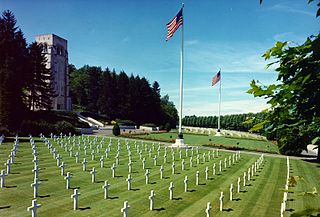 W
WThe Aisne-Marne American Cemetery and Memorial is a 42-acre (17 ha) World War I cemetery in Belleau, Northern France. It is located at the foot of the hill where the Battle of Belleau Wood was fought, with many American fatalities. The cemetery also contains burials from the Battle of Château-Thierry, later that summer.
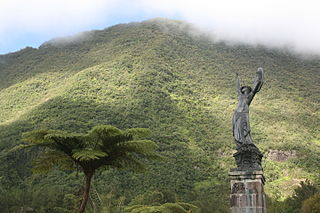 W
WL'Âme de la France is the name given by the French sculptor Carlo Sarrabezolles to three identical monumental statues that he executed in three different materials during the interwar period, the first in plaster in 1921, the second in stone in 1922, and the last in bronze in 1930. 3.2 metres tall, they represent a female warrior with naked breasts raising her arms toward the sky.
 W
WThe Arras Flying Services Memorial Commonwealth War Graves Commission war memorial in the Faubourg d'Amiens Cemetery, Arras, France. The memorial commemorates nearly 1,000 airmen from forces of the Commonwealth who were killed on the Western Front during World War I and who have no known grave. The memorial was designed by Edwin Lutyens, sculpted by William Reid Dick and unveiled by Hugh Trenchard, 1st Viscount Trenchard, Marshal of the Royal Air Force on 31 July 1932.
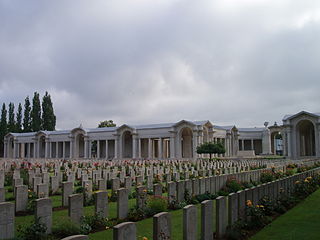 W
WThe Arras Memorial is a World War I memorial in France, located in the Faubourg d'Amiens British Cemetery, in the western part of the town of Arras. The memorial commemorates 35,942 soldiers of the forces of the United Kingdom, South Africa and New Zealand, with no known grave, who died in the Arras sector between the spring of 1916 and 7 August 1918.
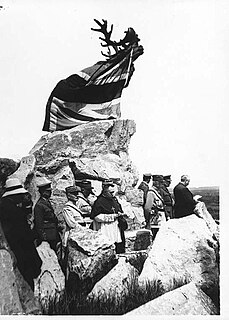 W
WThe Beaumont-Hamel Newfoundland Memorial is a memorial site in France dedicated to the commemoration of Dominion of Newfoundland forces members who were killed during World War I. The 74-acre (300,000 m2) preserved battlefield park encompasses the grounds over which the Newfoundland Regiment made their unsuccessful attack on 1 July 1916 during the first day of the Battle of the Somme.
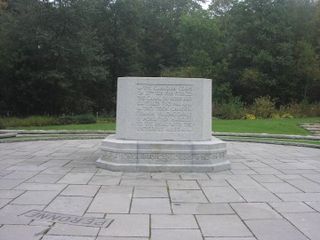 W
WThe Bourlon Wood Memorial is a Canadian war memorial that commemorates the actions of the Canadian Corps during the final months of the First World War; a period also known as Canada's Hundred Days, part of the Hundred Days Offensive. Particularly celebrated are the Canadian Corps crossing of the Canal du Nord, their flushing the German forces from Bourlon and Bourlon Wood and the 'Pursuit to Mons' through Cambrai, Denain, Valenciennes and into Mons on 11 November 1918. It is located adjacent to the town of Bourlon.
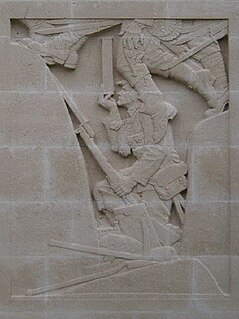 W
WThe Cambrai Memorial to the Missing is a Commonwealth War Graves Commission (CWGC) memorial for the missing soldiers of World War I who fought in the Battle of Cambrai on the Western Front.
 W
WThe Canadian National Vimy Memorial is a war memorial site in France dedicated to the memory of Canadian Expeditionary Force members killed during the First World War. It also serves as the place of commemoration for Canadian soldiers of the First World War killed or presumed dead in France who have no known grave. The monument is the centrepiece of a 100-hectare (250-acre) preserved battlefield park that encompasses a portion of the ground over which the Canadian Corps made their assault during the initial Battle of Vimy Ridge offensive of the Battle of Arras.
 W
WThe War memorial of Céret is a World War I memorial in France, located in Céret (Pyrénées-Orientales). The sculpture for the memorial was made from 1919 to 1920 by Aristide Maillol and the memorial itself was inaugurated in 1922. It was declared a national monument in 1994.
 W
WThe Château-Thierry American Monument is a World War I memorial, dedicated in 1937, located near Château-Thierry, Aisne, France. Architecturally it is a notable example of Stripped Classicism.
 W
WThe Compiègne Wagon was the train carriage in which both the Armistice of 11 November 1918 and Armistice of 22 June 1940 were signed.
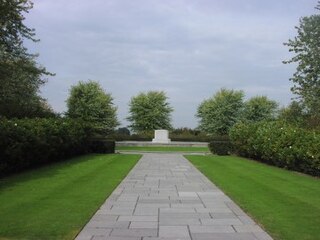 W
WThe Courcelette Memorial is a Canadian war memorial that commemorates the actions of the Canadian Corps in the final two and a half months of the infamous four-and-a-half-month-long Somme Offensive of the First World War. The Canadians participated at the Somme from early September to the British offensives end in mid-November 1916, engaging in several of the battles-within-the-battle of the Somme, including actions at: Flers-Courcelette, Thiepval Ridge, the Ancre Heights, the Ancre as well as a small role in providing relief to the First Australian Imperial Force in the final days of the Battle of Pozières. The battles on the Somme were the first in which all four Canadian divisions participated in the same battle, although not together in a cohesive formation. The Canadian divisions suffered over 24,000 casualties.
 W
WThe Courtrai Memorial is a Dominion of Newfoundland war memorial in Kortrijk, Belgium that commemorates the actions of the Royal Newfoundland Regiment during the First World War when it served and fought in several campaigns in Belgium from 1916 to 1918.
 W
WThe Delville Wood South African National Memorial is a World War I memorial, located in Delville Wood, near the commune of Longueval, in the Somme department of France. It is opposite the Delville Wood Commonwealth War Graves Commission Cemetery, on the other side of the Longueval–Ginchy road.
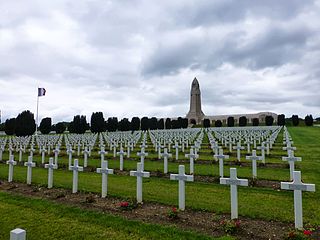 W
WThe Douaumont ossuary is a memorial containing the skeletal remains of soldiers who died on the battlefield during the Battle of Verdun in World War I. It is located in Douaumont, France, within the Verdun battlefield. It was built on the initiative of Charles Ginisty, Bishop of Verdun. It has been designated a "nécropole nationale".
 W
WThe Dury Memorial is a World War I Canadian war memorial that commemorates the actions of the Canadian Corps in the Second Battle of Arras, particularly their breakthrough at the Drocourt–Quéant Line switch of the Hindenburg Line just south of the town of Dury. The Drocourt–Quéant Line was a main position in the German Army's defensive position in the area. The action took place on 2 and 3 September 1918 during a period known as the Hundred Days Offensive or Canada's Hundred Days. Particularly noteworthy for such a brief battle was that seven Canadians earned a Victoria Cross on 2 September during the battle.
 W
WThe Glade of the Armistice is a French national and war memorial in the Forest of Compiègne in Picardy, France, near the city of Compiègne and approximately 60 kilometres (37 mi) north of Paris. It was built at the location where the Germans signed the Armistice of 11 November 1918 that ended World War I. During World War II, Adolf Hitler chose the same spot for the French and Germans to sign the Armistice of 22 June 1940 after Germany won the Battle of France. The site was destroyed by the Germans but rebuilt after the war.
 W
WThe Gueudecourt Memorial is a Dominion of Newfoundland war memorial that commemorates the actions of the Royal Newfoundland Regiment during the Battle of Le Transloy, a sub-battle of the Battle of the Somme of World War I. Located about 1-kilometre (0.62 mi) north-east of Gueudecourt village, the memorial marks the spot where in October 1916, the Royal Newfoundland Regiment played a decisive role in the capture and holding of a German strong-point. The site also marks the furthest point of advance from the July 1st starting line of all British units during the Battle of the Somme.
 W
WHartmannswillerkopf, also known as the Vieil Armand (French) or Hartmannsweiler Kopf is a pyramidal rocky spur in the Vosges mountains of the Grand Est region, France. The peak stands at 956 metres (3,136 ft) overlooking the Rhine valley. At Hartmannswillerkopf stands a national monument of World War I for the fighting which took place in the trenches here.
 W
WThe Hohenzollern Redoubt was a strongpoint of the German 6th Army on the Western Front during the First World War, at Auchy-les-Mines near Loos-en-Gohelle in the Nord-Pas-de-Calais region of France. Named after the House of Hohenzollern, the redoubt was fought for by German and British forces. Engagements took place from the Battle of Loos (25 September – 14 October 1915) to the beginning of the Battle of the Somme on 1 July 1916, including the Action of the Hohenzollern Redoubt in 1915 and the British Attack at the Hohenzollern Redoubt from 2 to 18 March 1916.
 W
WChâteau de Hunebourg lies to the west of Neuwiller-lès-Saverne in the French département of Bas-Rhin on a 425-metre-high sandstone rock outcrop. It is accessible from the valley of the Zinsel du Nord. The original castle was built in the 12th-13th century, but very little remains from this period. The castle was reconstructed in a neo-romanesque style in the 1930s. It is a listed historical monument since 2007.
 W
WL’Anneau de la Mémoire is a World War I memorial in Ablain-Saint-Nazaire, France. Designed by Philippe Prost and inaugurated on November 11, 2014, the 96th anniversary of Armistice Day, the memorial honors the 576,606 soldiers of forty different nationalities who died at Nord-Pas-de-Calais. The memorial is located at the site of the national cemetery of Notre-Dame-de-Lorette. The monument consists of 500 metal panels that are arranged in an ellipse pattern, each 3 meters in height. Each panel contains approximately 1200 names of fallen soldiers, listed alphabetically by last name. The 500th panel remains blank so that any newly discovered names may be inscribed. The most noteworthy aspect of the Ring of Memory is that it is the first memorial to list alphabetically, with no regard to rank nor nationality.
 W
WThe La Ferté-sous-Jouarre memorial is a World War I memorial in France, located on the south bank of the River Marne, on the outskirts of the commune of La Ferté-sous-Jouarre, 66 kilometres east of Paris, in the department of Seine-et-Marne. Also known as the Memorial to the Missing of the Marne, it commemorates over 3,700 British and Irish soldiers with no known grave, who fell in battle in this area in August, September and early October 1914. The soldiers were part of the British Expeditionary Force, and are listed on the memorial by regiment, rank and then alphabetically.
 W
WThe Le Quesnel Memorial is a Canadian war memorial that commemorates the actions of the Canadian Corps during the 1918 Battle of Amiens during World War I. The battle marked the beginning of a 96-day period known as "Canada's Hundred Days" that saw the crumbling of the German Army and ultimately the Armistice that ended the war. The memorial is located just to the southwest of the village of Le Quesnel, on the road between Amiens and Roye, in northern France.
 W
WThe Le Touret Memorial is a World War I memorial, located near the former commune of Richebourg-l'Avoué, in the Pas-de-Calais region of France. The memorial lists 13,389 names of British and Commonwealth soldiers with no known grave who were killed in the area prior to the start of the Battle of Loos on 25 September 1915. The exceptions are Canadian soldiers, whose names are commemorated at the Vimy Memorial, and Indian Army soldiers, whose names appear on the Neuve-Chapelle Memorial. Those commemorated on this memorial include the Victoria Cross recipients Abraham Acton, William Anderson, Jacob Rivers, and Edward Barber. Also commemorated here are Clive and Arnold Baxter, brothers who were killed on the same day, 25 January 1915, in the Brickstacks area of Cuinchy.
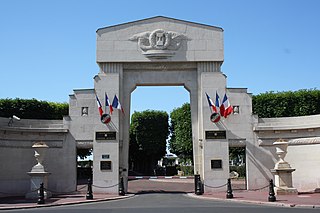 W
WThe Levallois-Perret Cemetery is a cemetery in the commune of Levallois-Perret in the northwestern suburbs of Paris, France. Strictly speaking it is just outside Paris in the arrondissement of Nanterre, in the Hauts-de-Seine department, in the Île-de-France region.
 W
WThe Loos Memorial is a World War I memorial forming the sides and rear of Dud Corner Cemetery, located near the commune of Loos-en-Gohelle, in the Pas-de-Calais département of France. The memorial lists 20,610 names of British and Commonwealth soldiers with no known grave who were killed in the area during and after the Battle of Loos, which started on 25 September 1915. This memorial covers the same sector of the front as the Le Touret Memorial, with each memorial commemorating the dead either side of the date of the start of the Battle of Loos.
 W
WThe Masnières Newfoundland Memorial is a Dominion of Newfoundland war memorial that commemorates the actions of the Royal Newfoundland Regiment during the First Battle of Cambrai, of World War I. Located at the north end of the town of Masnières, France, the memorial commemorates the participation of the Newfoundlanders in the taking and defense of the town during the First Battle of Cambrai between 20 November and 2 December 1917.
 W
WMcCrae's Battalion Great War Memorial is a World War I memorial cairn located in the village of Contalmaison, France. Designed by the historian, Jack Alexander, it was unveiled in 2004 after being first proposed by survivors of the battalion in 1919. As such, it is the last of the 'original' Great War memorials to be built. It commemorates the dead of the 16th Royal Scots volunteer battalion formed by Sir George McCrae, known as 'The Sporting Battalion', who participated in the First Battle of the Somme, July 1916.
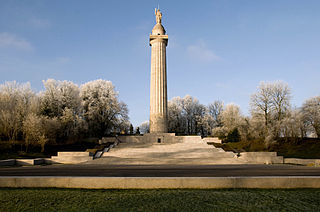 W
WThe Meuse-Argonne American Memorial is an American World War I memorial commemorating "the brilliant victory of the American First Army in the Meuse-Argonne offensive, September 26 – November 11, 1918, and pays tribute to the previous heroic services of the Armies of France on the important battle front upon which the memorial has been constructed." It was erected by the United States Government and is the largest of the American war memorials in Europe. Outside Montfaucon in the Meuse department in Grand Est in north-eastern France, it was unveiled on August 1, 1937. The memorial was designed by John Russell Pope. He designed a massive, Doric column in granite. It is surmounted by a statue symbolic of liberty and towers more than 200 feet (61 m) above the hill and the war ruins of the village around it.
 W
WThe Monchy-le-Preux Memorial is a Dominion of Newfoundland war memorial that commemorates the actions of the Royal Newfoundland Regiment during the Battle of Arras of World War I.
 W
WMont Saint-Quentin Australian war memorial, located in Mont Saint-Quentin region of Picardy, is an Australian First World War memorial.
 W
WMonument to the Heroes of the Black Army is the name of a war memorial on Place de la Liberté, Bamako, Mali, and its replica, with a different base, located in Parc de Champagne in Reims, France, commemorating the role of African soldiers in the defense of the city in the summer of 1918. The memorial in Bamako was inaugurated in January 1924, and the original replica in Reims in July of the same year.
 W
WMonuments aux Morts are French war memorials established to commemorate the losses of World War I. After the end of the 1914–1918 war there was a frenzy to build memorials to commemorate those who had been killed and it has been calculated that in this period well over 36,000 individual memorials were erected throughout France with the majority of these being built between 1919 and 1926. These memorials are known as monuments aux morts - literally monuments to the dead and what are known in the United Kingdom as war memorials.
 W
WThe Neuve-Chapelle Indian Memorial is a World War I memorial in France, located on the outskirts of the commune of Neuve-Chapelle, in the département of Pas-de-Calais. The memorial commemorates some 4,742 Indian soldiers with no known grave, who fell in battle while fighting for the British Indian Army in the First World War. The location of the memorial was chosen because of the participation by Indian troops at the Battle of Neuve Chapelle.
 W
WCharles-Henri Pourquet, born Henri Charles Justin Pourquet was a French sculptor.
 W
WThe Pozières Memorial is a World War I memorial, located near the commune of Pozières, in the Somme department of France, and unveiled in August 1930. It lists the names of 14,657 British and South African soldiers of the Fifth and Fourth Armies with no known grave who were killed between 21 March 1918 and 7 August 1918, during the German advance known as the Spring Offensive, and the period of Allied consolidation and recovery that followed. The final date is determined by the start of the period known as the Advance to Victory on 8 August.
 W
WThe St. Mihiel American Cemetery and Memorial is located at the west edge of Thiaucourt (Meurthe-et-Moselle), France. The 40.5 acres (16.4 ha) cemetery contains the graves of 4,153 American military dead from World War I. The majority of these died in the Battle of Saint-Mihiel, an offensive that resulted in the reduction of the St. Mihiel salient that threatened Paris.
 W
WThe Sir John Monash Centre is a museum and interpretive centre that commemorates Australian servicemen and women who served on the Western Front during the First World War. The centre, located near the village of Villers-Bretonneux (Somme) in northern France, is set behind the Villers–Bretonneux Australian National Memorial and within the military cemetery. The centre opened in April 2018.
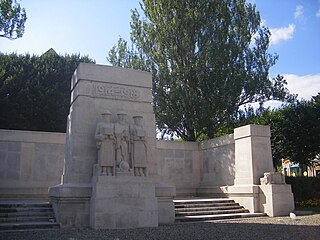 W
WThe Soissons Memorial is a World War I memorial located in the town of Soissons, in the Aisne département of France. The memorial lists 3,887 names of British soldiers with no known grave who were killed in the area from May to August 1918 during the Spring Offensive. The battles fought by those commemorated here include the Third Battle of the Aisne and the Second Battle of the Marne.
 W
WSomme American Cemetery and Memorial in France is situated ½ mile southwest of the commune of Bony, Aisne in northern France. It is located on a gentle slope typical of the open, rolling Picardy countryside.
 W
WThe Suresnes American Cemetery and Memorial is a United States military cemetery in the Suresnes, Hauts-de-Seine, France. It is the resting place of 1,541 American soldiers killed in World War I. A panoramic view of Paris can be seen from the site, which is located high on the slopes of Mont Valérien.
 W
WThe Thiepval Memorial to the Missing of the Somme is a war memorial to 72,337 missing British and South African servicemen who died in the Battles of the Somme of the First World War between 1915 and 1918, with no known grave. It is near the village of Thiepval, Picardy in France. A visitors' centre opened in 2004. Designed by Sir Edwin Lutyens, Thiepval has been described as "the greatest executed British work of monumental architecture of the twentieth century".
 W
WThe Ulster Tower, located in Thiepval, France, is Northern Ireland's National War Memorial. It was one of the first memorials to be erected on the Western Front and commemorates the men of the 36th (Ulster) Division and all those from Ulster who served in the First World War. The memorial was officially opened on 19 November 1921 and is a very close copy of Helen's Tower which stands in the grounds of the Clandeboye Estate, near Bangor, County Down, Northern Ireland. Many of the men of the Ulster Division trained in the estate before moving to England and then France early in 1916.
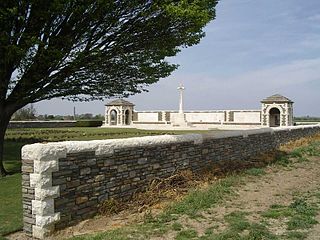 W
WThe V.C. Corner Australian Cemetery and Memorial is a Commonwealth War Graves Commission World War I cemetery and memorial. The site is located in the commune of Fromelles, in the Nord departement of France, about 2 kilometres (1.2 mi) northwest of the village of Fromelles on the D22C road (rue Delval).
 W
WThe Verdun Memorial is a war memorial to commemorate the Battle of Verdun, fought in 1916 as part of the First World War. It is situated on the battlefield, close to the destroyed village of Fleury-devant-Douaumont in the département of Meuse in north-eastern France.
 W
WThe Australian National Memorial, Villers-Bretonneux is the main memorial to Australian military personnel killed on the Western Front during World War I. It is located on the Route Villiers-Bretonneux (D 23), between the towns of Fouilloy and Villers-Bretonneux, in the Somme département, France. The memorial lists 10,773 names of soldiers of the Australian Imperial Force with no known grave who were killed between 1916, when Australian forces arrived in France and Belgium, and the end of the war. The location was chosen to commemorate the role played by Australian soldiers in the Second Battle of Villers-Bretonneux.
 W
WThe Vis-en-Artois Memorial is a World War I memorial located near the commune of Vis-en-Artois, in the Pas-de-Calais département of France. The memorial lists 9,843 names of British and South African soldiers with no known grave who were killed during the Advance to Victory, from 8 August 1918 to the Armistice. The area of the frontline covered is described as "in Picardy and Artois, between the Somme and Loos". Canadian, Australian and New Zealand forces that fell during this period and were not found, are commemorated elsewhere on other memorials to the missing.
 W
WThe War memorials (Oise) or Monuments aux Morts of Oise are French war memorials commemorating those men of the region who died in World War I.
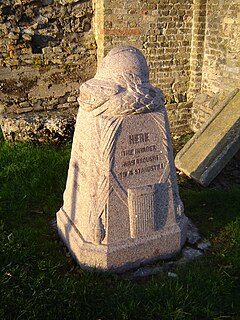 W
WWestern Front demarcation stones, also known as Bornes du Front and Bornes Vauthier, are monuments erected in France and Belgium to mark the limit of the German advance during the First World War. The stones were the idea of sculptor Paul Moreau-Vauthier, a veteran of the war, and were erected between 1921 and 1930. The total number of stones erected is unclear but it is thought that there were 118 official stones, of which 93 survive. The stones identify the army that held that sector in 1918 and are engraved with the text "Here the invader was brought to a standstill 1918" in English, Dutch, and French.